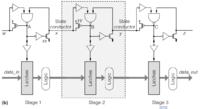MZulkarnain Jaranee
Newbie level 5
Problem in Gasp Pipeline Controller in VHDL
Hi everyone,
I'm working on the Gasp Controller as shown within the red area in the image attachment 111734. I did the code but the problem is the result didn't display as what show in the below image. Could anyone please advice/assist on this.
**broken link removed**
Here is the code
Here is the netlist viewer result :
**broken link removed**
In the netlist viewer, the n_out, p_out and en all connected to input wire before y.
Hi everyone,
I'm working on the Gasp Controller as shown within the red area in the image attachment 111734. I did the code but the problem is the result didn't display as what show in the below image. Could anyone please advice/assist on this.
**broken link removed**
Here is the code
Code:
LIBRARY ieee;
USE ieee.std_logic_1164.all;
LIBRARY work;
ENTITY gaspblock IS
PORT
(
x,y : inout STD_LOGIC;
en : out STD_LOGIC;
n_Out, p_out: buffer STD_LOGIC
);
END gaspblock;
ARCHITECTURE bdf_type OF gaspblock IS
signal B, yy, a : std_LOGIC;
BEGIN
B <= ((not x) nand y);
en <= not B;
a <= not B;
yy <= B;
---- n- transistor ------
process(a)
begin
case a is
when '0' | 'L' => n_Out <= '1';
when '1' | 'H' => n_Out <= '0';
when others => n_Out <= 'X';
end case;
end process;
------ p -transistor ------
process(yy)
variable control: std_Logic;
begin
case yy is
when '0' | 'L' => p_out <= '1';
when '1' | 'H' => p_out <= '0';
when others => p_out <= 'X';
end case;
end process;
x <= p_out;
y <= n_Out;
END bdf_type;Here is the netlist viewer result :
**broken link removed**
In the netlist viewer, the n_out, p_out and en all connected to input wire before y.
Last edited:

